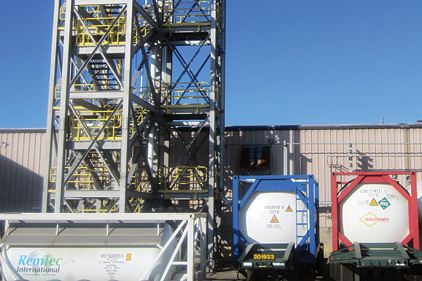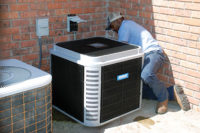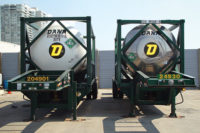
|
| A fractional distillation tower in Ohio. (Photo courtesy of A-Gas RemTec.) |
Reclamation is in a rut. Shortly after the arrival of the Montreal Protocol, 25 years ago, came the 3 R’s: Recover, Recycle, and Reclaim. Service technicians would recover refrigerant to avoid fines for illegal venting. They’d then run the gas through an on-site recycling machine to clean it up a bit. But if they were not sure how pure the stuff they were planning to put back into the system was, they would put a virgin version of the same refrigerant into the system and send the old stuff to off-site reclamation facilities, to be brought back to the certified highest level of purity — ARI 700.
The reality is that in 2012, and thus far in 2013, few technicians and contractors are bringing R-22 back for reclamation despite an abundance of capacity at many reclamation facilities.
“Based on the U.S. Environmental Protection Agency (EPA) report, the amount of R-22 reclaimed year over year has remained relatively flat for the past five to six years, hovering around 5 or 6 percent of HCFC-22 demand,” said Debra D. Goodge, refrigerant reclaim programs manager for DuPont. “Beginning in 2010 with the issuance of the Final Rule (regarding phase out of R-22), there was an expectation that reclaim would be needed to fill a projected R-22 supply-demand imbalance — somewhere in the neighborhood of 27.5 million pounds each year. For the past two years, there has not been an uptick in the amount of reclaimed R-22 going through reclaimers. It’s remained steady around 8 million pounds.”
Christopher Foutz, marketing manager, Honeywell Refrigerants, said, “The amount of R-22 reclaimed in 2011 was similar to the amount of R-22 that was reclaimed in 2006.”
What’s the Problem?
“One of the major contributors to the flat or declining recovery rate is that many R-22 users have adopted a practice of reusing their recovered refrigerant,” said Gordon McKinney, vice president and COO, ICOR Intl. “Even though some might be making an attempt to recycle (filter out particulates and/or separate out oils), without properly analyzing the recovered gas to determine composition and quality, the user and equipment owner are rolling the dice.”
Walt Baker, vice president of sales and marketing, Polar Technology, said, “A lot of this can be attributed to the commodity nature of refrigerant gases. Supplies are plentiful and prices reflect the availability of supplies. Therefore, the role of reclaim has been relegated to philosophies regarding environmental stewardship.”
Then there is the economics of reclamation for the contractor, said Ken Beringer, senior vice president of Airgas Refrigerants Inc. “The industry has not seen a significant increase in returned R-22 because, in my opinion, the majority of the product is harvested in small batches which do not have a great deal of value. Until January 2012, the returned gas had very little value and, in many cases, there was a disposal charge when the product was returned.”
Patti Conlan, who manages the reclaim program for Arkema, said, “In the past, the volume of reclaim has been low due to monetary gains not being passed down to the contractor level as an incentive to reclaim, as well as the possible legal and illegal reuse of R-22.”
Yet awareness is growing, said James Sweetman, president, Consolidated Refrigerant Solutions. “We have seen heightened awareness among contractors regarding the need to become involved in a viable reclaim program.”
Arkema’s Conlan is also predicting an uptick. “As the EPA has anticipated, we have just recently started to see an increase in reclaim coming back with the increasing price of R-22.”
Said Beringer, “With the phase
out of HCFCs, the amount returned should increase as the price of used gas continues to rise. The very rapid appreciation in new product pricing may have led to the illegal practice of filtering used product and introducing it into the system of a different owner.”
Ken Logan, president of A-Gas U.S. Holdings Inc., agrees, stating that “Currently the decreasing availability of virgin product is starting to make a difference. Over time the gap will widen further and the two will become inversely proportional.”
The HFC Factor
Also entering the equation is the industry’s focus on the use of HFC refrigerants as retrofits into systems originally designed for R-22. Owners of large amounts of equipment can move recovered R-22 around to not-yet-retrofitted systems and may or may not look at the reclamation option.
Honeywell’s Foutz said, “Retrofit HFC refrigerants have been available for several years. To date, the availability of the retrofit HFC refrigerants has not stimulated significant growth in R-22 reclamation. As R-22 supplies tighten, the economic incentive should stimulate retrofits to HFC refrigerants and stimulate R-22 reclamation growth.”
ICOR’s McKinney looks at the HFC retrofit from a historical perspective. “If given the opportunity, equipment owners will squeeze the most life out of their systems as possible. It was R-12-alternative HCFC refrigerants that played the most significant role in closing the supply/demand gap during the CFC phase out. Based upon the tremendous market shift in the last few months to HFC alternatives, history is set to repeat itself.”
He noted, “In the near future the R-22 supply — virgin and reclaimed — will be set aside for critical applications where alternative refrigerants are not suitable, such as flooded chillers and systems that have highly sophisticated refrigerant-specific controls.”
For A-Gas’s Logan, this can be iffy. “Keep in mind, retrofitting a system to a refrigerant it wasn’t initially designed for normally involves compromises and not everything is capable of retrofit. The industry itself will decide what can and cannot be retrofitted successfully. Retrofit activity will help conserve supplies of reclaimed R-22 overall.”
Jump Start
What will jump start the sector?
DuPont’s Goodge said, “It is a matter of supply-demand dynamics. If R-22 supply is limited, or the price increases dramatically, there is added incentive to manage the R-22 asset. A major element of a refrigerant management plan is extracting value from the installed R-22. Options include using recovered R-22 to do one or more of the following: gain access to lower-cost R-22 to continue to service equipment that remains on R-22, lowering the cost to retrofit existing equipment to an alternative HFC refrigerant, and/or reducing equipment replacement costs by extending the life of R-22 equipment by using either reclaimed R-22 or an HFC alternative.”
Airgas’s Beringer said it is a matter of economics, “People do not waste what is valuable. If the EPA had more enforcement, and made people accountable for their used product, then the culture would change. Higher pricing should help.”
As will awareness, said Consolidated’s Sweetman. “We believe that there is sufficient interest within the cooling and refrigeration industry to support increased reclamation. Companies that, for years, have been ‘kicking the can down the road’ or ‘dragging their butts’ are really starting to get on the ball. These contractors that have been conducting business as usual are finally reaching out to us for a more viable reclaim option.”
Publication date: 4/8/2013







